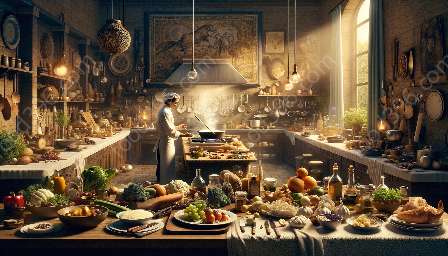Roman cuisine, with its rich history and diverse flavors, holds a distinct place within European culinary traditions. By delving into the roots of Roman gastronomy, we can uncover a fascinating journey that reflects cultural influences, traditional dishes, and the evolving nature of cuisine history.
The Origins of Roman Cuisine
Tracing the origins of Roman cuisine requires a look back at the ancient history of the Roman Empire. Roman food was deeply influenced by the availability of ingredients, as well as the culinary practices of neighboring cultures, such as the Greeks and Etruscans. The rich agricultural landscape of Italy provided a bounty of produce, grains, and livestock, all of which played a significant role in shaping Roman cooking.
The Influence of European Cuisine History
Understanding Roman cuisine within the context of European culinary history reveals the interconnectedness of flavors and techniques that have traversed borders and evolved over time. Roman cuisine has contributed to and been influenced by the broader European culinary landscape, creating a tapestry of flavors, ingredients, and traditions that continue to inspire contemporary gastronomy.
Traditional Roman Dishes
Traditional Roman dishes showcase the region's distinctive culinary identity. Pasta dishes, such as cacio e pepe and amatriciana, exemplify the simplicity and elegance of Roman cooking. Additionally, Roman cuisine is known for its delicious use of offal, such as in the renowned dish, trippa alla romana. Furthermore, the classic Jewish-Roman cuisine, epitomized by dishes like carciofi alla giudia (Jewish-style artichokes), demonstrates the multicultural influences that have shaped the local gastronomy.
The Evolution of Roman Cuisine
Over time, Roman cuisine has evolved to incorporate diverse influences, reflecting the city's vibrant cultural tapestry. Immigrations and historical events have introduced new ingredients and cooking methods to the Roman kitchen, creating a dynamic culinary landscape that continues to innovate while preserving its traditional roots.
Roman Cuisine in Modern Times
Today, Roman cuisine continues to thrive, with both traditional trattorias and modern eateries offering a taste of the city's culinary heritage. The emphasis on quality, locally-sourced ingredients remains at the heart of Roman cooking, ensuring that the essence of this ancient cuisine is carefully preserved while embracing contemporary trends and global influences.
Exploring the Roman Culinary Heritage
From the ancient culinary practices of the Roman Empire to the modern interpretations of traditional dishes, Roman cuisine offers a captivating journey through history and flavor. By understanding its place within European cuisine history and recognizing the nuances of its evolution, one can appreciate the lasting allure of Roman gastronomy.

